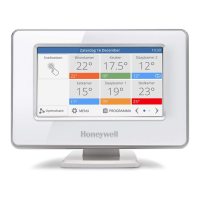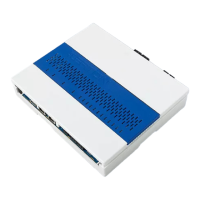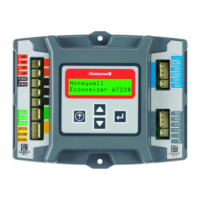ENGINEERING MANULA OF AUTOMATIC CONTROL
INDIVIDUAL ROOM CONTROL APPLICATIONS
406
M10539
75
55
1.4
52
350 943 1150 75
MINIMUM
AIRFLOW
SETPOINT (CFM)
INCHES OF
WATER
MAXIMUM
AIRFLOW
SETPOINT (CFM)
CURRENT
AIRFLOW
(CFM)
CURRENT SPACE
TEMPERATURE
SETPOINT
CURRENT SPACE
TEMPERATURE
AIRFLOW
ZERO
ADJUSTABLE
MINIMUM
AIRFLOW
ADJUSTABLE
MAXIMUM
AIRFLOW
LOW
HIGH
SPACE COOLING LOAD
PERCENT
OPEN
PRIMARY
AIR
Fig. 5. Variable Air Volume Single-Duct Air Terminal Unit.
Figure 5 displays the primary supply air temperature and static
pressure. These values are data points in the AHU digital
controller and not physical points at the VAV box. They will
vary when measured at the VAV boxes. When a BMS user looks
at a VAV box display, it is usually because a problem exists.
The fan system supply air temperature and static pressure are
necessary data for problem analysis.
Variable Air Volume ATU with Electric Reheat
The VAV ATU with electric reheat in Figure 6 adds reheat to
Figure 5. Figure 6 also shows four boxes on one display. The
cooling PID varies the box airflow from maximum to minimum
as the cooling load drops to maintain setpoint. If the cooling
load drops further, the space temperature drops through a dead
band until the heating setpoint is reached, at which point the
heating unit is controlled to maintain the heating setpoint. When
electric reheat is used, the heating PI may be modified with
software heat anticipation to advance the heater stages off
command to minimize wide swings in space temperature which
would result from simple temperature sensed control.
Although Figures 3, 4, 5, and 6 show several inputs, outputs,
and setpoints, many more parameters are available and
necessary to allow technicians to adapt the standard program
to a unique room and set of equipment. These additional
parameters, usually addressable and commandable from the
BMS or portable terminal, include the cooling loop PI gains,
the heating loop PI gains, reheat airflow setpoint, unoccupied
space temperature setpoint, standby temperature setpoint,
temperature sensor calibration offset, bypass push-button status,
bypass push-button override time in minutes, smoke purge mode
% of maximum airflow setpoint, smoke pressurization mode
% of maximum airflow setpoint, and unoccupied mode % of
maximum airflow setpoint.
NOTE: On-off electric heat control often requires a minimum
air velocity above that of the minimum cooling airflow
to prevent excessive heating element temperatures.
Constant Air Volume ATUs
The constant air volume (CAV) ATUs are similar to the
pressure independent VAV units, except they control at a single
air volume setpoint. They usually include reheat coils, an
associated room sensor that controls the heating, and are often
found connected to VAV AHUs which also have VAV boxes
and the associated varying duct static pressures. CAV units are
used where the room supply air volume must be maintained at
a constant value.
Induction VAV ATU
The induction VAV ATU (Fig. 7), uses induced return air as
the initial reheat medium. Induction VAV ATUs are usually
installed above the ceiling and draw return air from the plenum
created by a false ceiling. The controller resets the primary air
airflow control setpoint in unison to opening the return air
dampers per the operation cycle shown in Figure 7. As the
dampers open, more return air is induced into the unit and
recirculated into the space.

